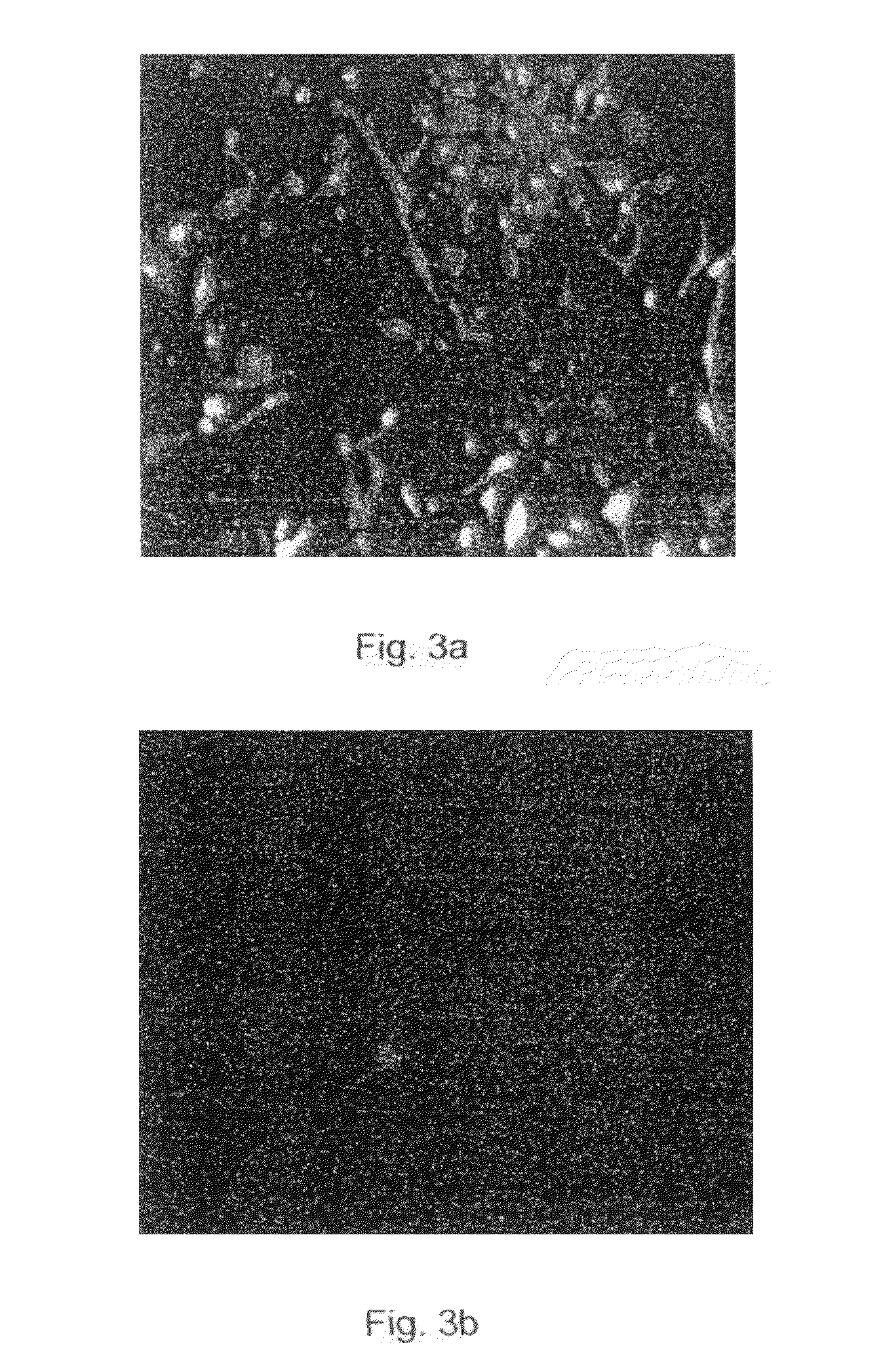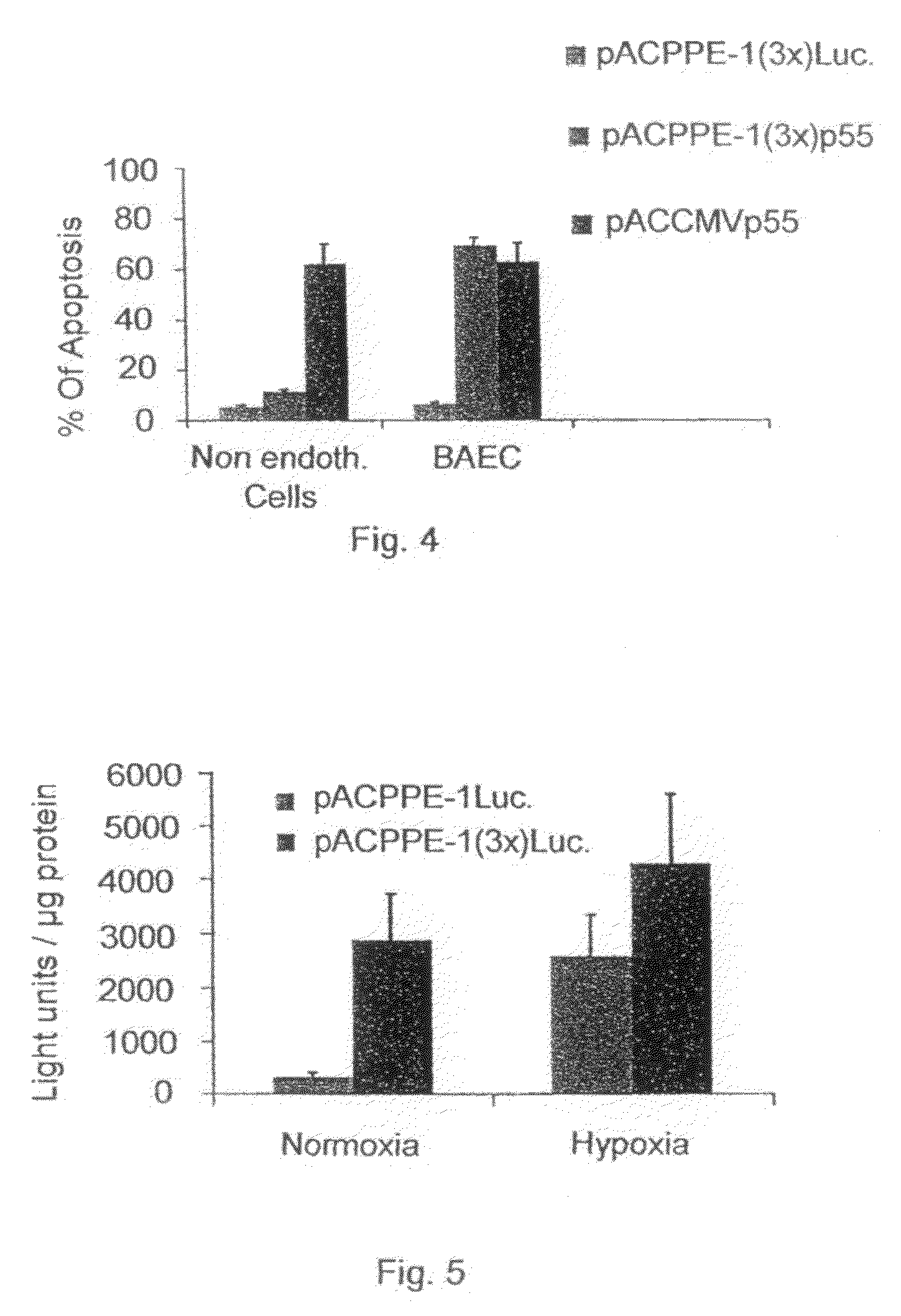Promoters exhibiting endothelial cell specificity and methods of using same
a technology of promoters and endothelial cells, applied in the field of modified preproendothelin1 promoters, can solve the problems of limiting their use in clinical settings, increasing the cost and difficulty of treatment, and major obstacles to effective and specific gene delivery, so as to increase the specificity of endothelial cells, enhance induction, and increase the expression of a sequence of interest.
- Summary
- Abstract
- Description
- Claims
- Application Information
AI Technical Summary
Benefits of technology
Problems solved by technology
Method used
Image
Examples
example 1
Analysis of 3X-PPE-1 Plasmid Activity In-Vitro
[0222]In order to analyze the activity of the PPE-1-3X, a comparison of reporter gene expression in the PPE-1-3X promoter plasmid and the unmodified PPE-1 promoter plasmid was undertaken. Reporter gene plasmids containing either the PPE-1-3X fragment or the unmodified PPE-1 fragment and the reporter gene Luciferase were transfected into endothelial and non-endothelial cell lines as well as to a bronchial epithelium cell line (B2B) which express the PPE-1 promoter (see materials and methods above). The B2B cell line was chosen to provide an indication of the 3X element's capacity to reduce expression in non-endothelial cell lines relative to the PPE-1 promoter. Transfection was accomplished using lipofectamine (Promega Corp., Madison, Wis.). A βgal-neo plasmid was employed as an indicator of the transfection efficiency in each case according to accepted molecular biology practice.
[0223]Forty-eight hours post transfection, the cells were h...
example 2
Activity and Specificity of AdSPPE-1 / Luciferase In-Vitro
[0225]The PPE-1 / Luciferase, PPE-1-3X / Luciferase, PPE-1 / GFP and PPE-1-3X / GFP were also ligated into the Ad5 plasmid to produce Ad5PPE-1 / Luc and Ad5PPE-1-3X / luc, Ad5PPE-1 / GFP and Ad5PPE-1-3X / GFP (Varda-Bloom et al., (2001) Gene therapy 8:819-827). These constructs were assayed separately as detailed hereinbelow.
[0226]In order to test the activity of the Ad5PPE-1 / luc, transfections of B2B (Human bronchial epithelial), BAEC (Bovine Aortic Endothelial Cells) and HUVEC (Human Umbilical Vein Endothelial Cells) were undertaken. These three cell lines express the endothelin gene and were chosen to indicate levels of expression of the tested construct in an endothelial cell. The RIN (Rat Insulinoma) cell line, which does not express endothelin, was employed as a negative control and transfected with the same construct. Ad5CMVLuc (Luciferase under the control of CMV promoter) was used as non-endothelial-specific control in all cell lines....
example 3
Activity and Specificity of AdSPPE-3XLuc and Ad5PPE-3XGFP
[0228]The Ad5PPE-3X / Luciferase and Ad5PPE-3X / GFP constructs were used to transfect the cell lines described hereinabove in Example 2 in order to ascertain the impact of the 3X element on specificity and expression levels. As in example 2, Ad5CMVLuc was used as a non-endothelial-specific control. Higher Luciferase expression in BAEC and HUVEC cell lines was detected under the control of the PPE-3X promoter as compared to the CMV promoter.
[0229]FIG. 3A is a photomicrograph illustrating GFP expression under the control of Ad5PPE-1-3X in the BAEC cell line. FIG. 3B is a photomicrograph illustrating GFP expression of Ad5CMV in the BAEC line. As is clearly shown by these Figures, the PPE-1-3X promoter is more active in endothelial cells. These results clearly indicate that the 3X element does not detract from the endothelial specificity of the PPE-1 promoter. Relative activities of the PPE-1 and PPE-1-3X promoters in cell culture ar...
PUM
| Property | Measurement | Unit |
|---|---|---|
| thickness | aaaaa | aaaaa |
| size | aaaaa | aaaaa |
| concentration | aaaaa | aaaaa |
Abstract
Description
Claims
Application Information
 Login to View More
Login to View More - R&D
- Intellectual Property
- Life Sciences
- Materials
- Tech Scout
- Unparalleled Data Quality
- Higher Quality Content
- 60% Fewer Hallucinations
Browse by: Latest US Patents, China's latest patents, Technical Efficacy Thesaurus, Application Domain, Technology Topic, Popular Technical Reports.
© 2025 PatSnap. All rights reserved.Legal|Privacy policy|Modern Slavery Act Transparency Statement|Sitemap|About US| Contact US: help@patsnap.com



